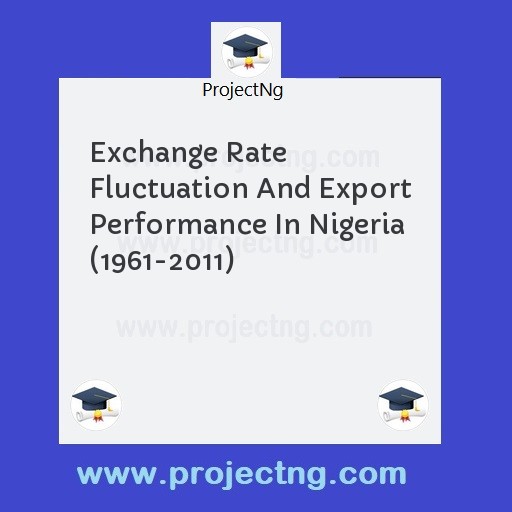Exchange Rate Fluctuation And Export Performance In Nigeria (1961-2011)
Economics Project Topics
Get the Complete Project Materials Now! »
EXCHANGE RATE FLUCTUATION AND EXPORT PERFORMANCE IN NIGERIA (1961-2011)
CHAPTER ONE
1.0 BACKGROUND OF THE STUDY
Exchange rate is a prominent determinant of world trade, receiving much attention in the context of global imbalances. The subject of exchange rate fluctuation came to be a topical issue in Nigeria because it is the goal of every economy to have a stable rate of exchange with its trading partners. In Nigeria, this goal was not realized in spite of the fact that they embarked on the devaluation of the naira and adopted the Structural Adjustment Program (SAP) in 1986. The failure to realize this goal subjected the Nigerian manufacturing sector to the challenge of a constantly fluctuating exchange rate.
One objective of the SAP was the restructuring of the production base of the economy with a positive bias for the production of agricultural export. The foreign exchange reforms that facilitated a cumulative depreciation of the effective exchange rate were expected to increase the domestic prices of agricultural exports and hence boost domestic production.
12
Empirically many researchers like Oyejide (1986), Ihimodu (1993) and World Bank (1994) analyzed the effects of cumulative depreciation of the effective exchange rate, as it resulted in the change in the structure and value of Nigeria’s exports. The depreciation increased the prices of agricultural exports and the result indicated a worked increase in the volume of agricultural exports over the years. However, very little achievements were made in stabilizing the rate exchange. As a consequence, the problem of exchange rate fluctuations in Nigeria persists up till date.
Fluctuation is a major constraint on development of an economy, making planning more problematic and investment more risky. For instance, fluctuation in exchange rate may reduce the activities of potential investors in Nigeria because it increases uncertainty over the returns of a given investment. Potential investors will invest in a foreign location only if the expected returns are high enough to cover for the currency risk (Gerado, 2002). Risk in international commodity trade usually arises from two main sources; changes in world prices or fluctuation in exchange rate. Therefore, understanding the behavior of the exchange rate is very important for many reasons. First, the
13
relationship between a country’s exchange rate and economic growth via trade is a crucial issue from both the descriptive and policy prescription perspective. As Edwards (1994; 61) asserts; “it is not an overstatement to say that the issue of real exchange rate behavior now occupies a central rate in policy evaluation and design”. A country’s exchange rate behavior is an important determinant of the growth rate of its exports and it serves as a measure of its international competitiveness (Bath and Amusa, 2003), Chukwu (2007)observed the instability exchange rate as a determinant of trade in Nigeria; having a positive influence on export trade and at other times a negative influence. This suggests an erratic change in its value having a long-run effect on export and economic growth. This research aims to determine the impact of fluctuations in the naira exchange rate on Nigerian’s export performance.
Be the First to Share On Social















